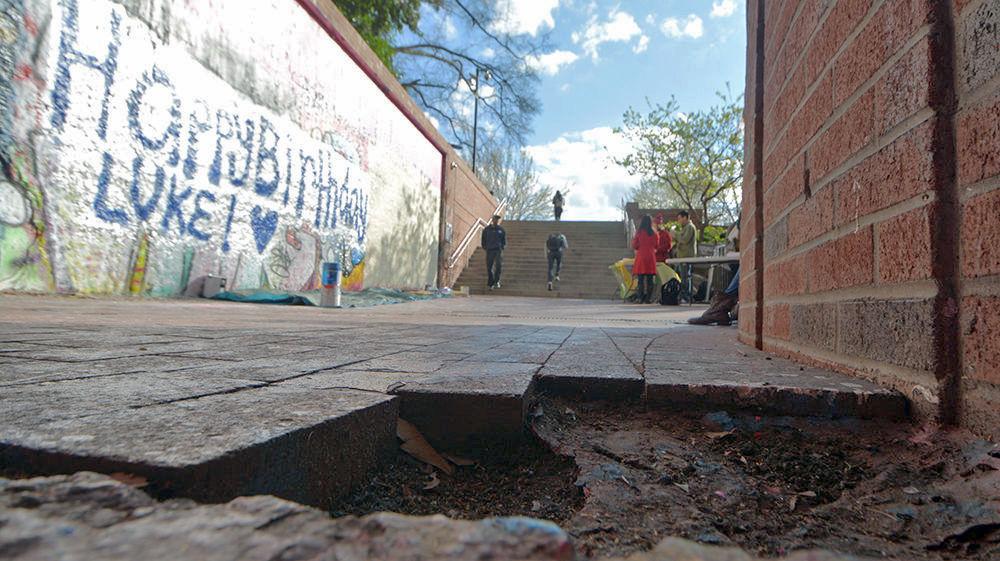The recent “beat the Brick Bandit” campaign has taken aim at individuals who choose to take bricks from walkways by providing alternatives to the tradition and increasing awareness of this issue.
Jeff Del Pinal, the grounds services program manager at NC State and head of the “beat the Brick Bandit” program, explained the need for this sort of initiative on NC State’s campus.
“We had a lot of issues, particularly around graduation time, where bricks would be taken out of the hardscape and that was causing a lot of issues,” Del Pinal said. “Trip and fall hazards, that kind of thing.”
Del Pinal emphasized how grounds services personnel are responsible for maintaining the lawns, removing debris and mulching in addition to repairing the stolen bricks, which can be costly because of time.
“It became such an issue to the point where we were spending quite a lot of time repairing the bricks,” Del Pinal said. “It’s not just a matter of throwing a brick back into the missing spot; it takes about 15 minutes of labor per brick. If you multiply that by, you know, hundreds across campus, it adds up after a while.”
According to Del Pinal, if bricks are missing from paths, it can be quite dangerous as people can trip and get hurt or crash on a bike due to a hole in the path that can injure not only the rider but also others in their way.
“It’s a safety hazard,” Del Pinal said. “We have a lot of folks on campus and we just want to make campus safe. When there are voids in the sidewalk, it’s an opportunity for someone to get hurt. We try to protect people that way.”
Ayla Adamec, a third year studying science, technology and society, expressed her concerns about brick theft.
“I’ve seen people fall because of not having bricks,” Adamec said. “I’ve almost sprained my ankle because of tripping, going down into a little ditch of non-brick. I’ve always been afraid to ride a bike, scooter or longboard around campus because of just not having bricks there.”
Del Pinal hopes those that those thinking of taking bricks would consider the impact on the grounds staff before taking a brick for themselves.
“Think about their pride in their school, protecting university assets,” Del Pinal said. “It’s not so much just about having a souvenir; it’s about what it causes after the fact. After that brick is gone and they’ve left campus, they kind of forget about it, but we’re left with the void of a brick and the side effects of it.”
The tradition of taking a brick has existed for a long time, as some graduating students use it as a treasure of their memories at the university. Adamec discussed how she had seen students partake in the tradition in the past.
“Students will come and steal bricks because they’re graduating.” Adamec said. “I’ve actually seen them holding bricks that are dirty and everything like that so it looks like they just took some somewhere.”
Grounds Services does provide students with alternatives to taking bricks straight out of paths. At the end of each semester, surplus bricks are available near the Brickyard, and students can directly request bricks through email. The Brick Bandit campaign has also had piles of bricks by posters around campus.
“There’s a historical meaning behind students acquiring brick, so we came up with the idea of offering surplus brick as a means to offset people taking it out of the physical hardscape,” Del Pinal said. “The bricks that we put out, that we offer for free, they’ve taken them. We’ve been able to work with housing, some campus partners to kind of create that momentum, get that word out. I think it’s helped a lot.”
While the surplus bricks have been popular, not everyone thinks that’s the best route to take the tradition. Adamec doesn’t quite think surplus bricks have the same meaning.
“I see locations around where it has a sign and it says ‘take a brick,’” Adamec said. “It kind of defeats the purpose of the tradition, because the tradition is to take a brick, like from the ground … I wouldn’t go and actually steal a brick, because that’s really dangerous.”
Del Pinal also mentioned that the campaign will undergo further tweaking, becoming less about the Brick Bandit persona and more about general education.
“There was an attempt to put a little humor in the campaign, have a little fun,” Del Pinal said, “but we’ve revisited that and we’re going to have more of a generic verbiage, try to stay away from anything that can be misconstrued in any way. We’re going to revisit that, we’re going to have more eyes on the signs that are made up and that kind of thing, trying to keep it more generic.”
The discussion surrounding brick theft has become more popular the last two years, which was the main initiative, according to Del Pinal. Additionally, brick theft seems to have decreased in the recent few years.
“I think there’s been a slight reduction; it still happens,” Del Pinal said. “But I think people are talking about it and there’s a little bit more awareness. And I think that’s going to lead to some better results down the road.”








